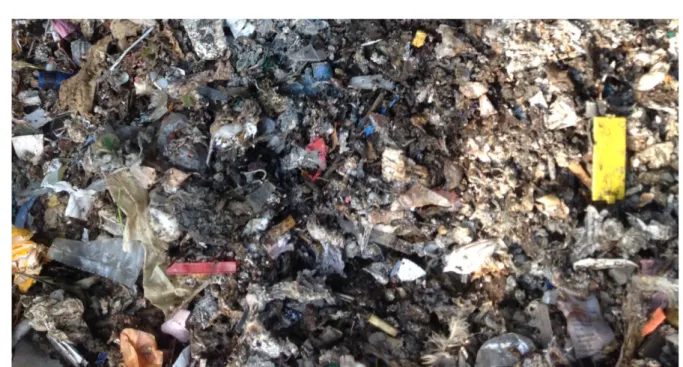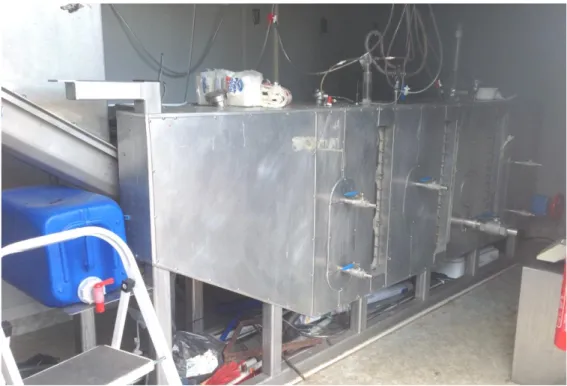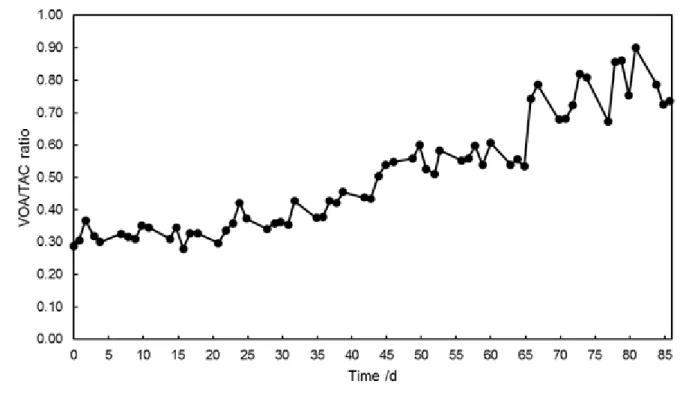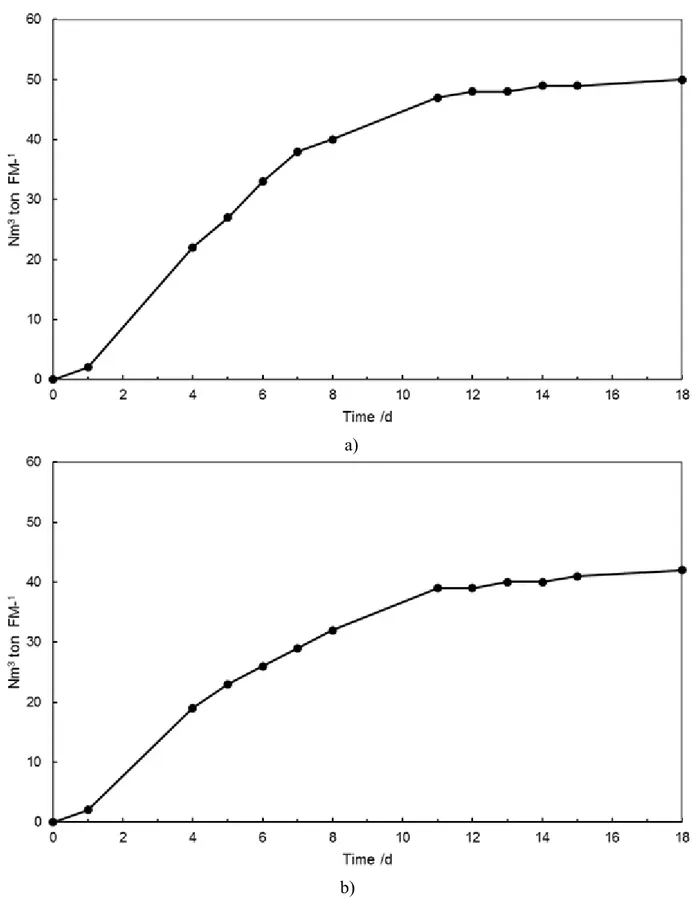Proceedings Sardinia 2015, Fifteenth International Waste Management and Landfill Symposium S. Margherita di Pula, Cagliari, Italy; 5 – 9 October 2015
2015 by CISA Publisher, Italy
RESIDUAL MUNICIPAL WASTE AS
SUBSTRATE
E. THORIN*, S. SCHWEDE*, J. LINDMARK* AND T. AHRENS**
* School of Business, Society and Engineering, Mälardalen University, P O Box 883,
SE-721 23 Västerås, Sweden
** Ostfalia University of Applied Sciences, Fachhochschule Braunschweig /
Wolfenbüttel (BUA), Salzdahlumer Str. 46/48, D-38302 Wolfenbüttel, Germany
SUMMARY: A pilot plug-flow dry digestion process was tested for production of biogas from the fine fraction of the residual municipal solid waste after source sorting of the organic fraction of the waste. The residual waste is complex, containing a mix of hard and soft plastic, paper, metal, glass, and a varying amount of organic material. The utilization as a substrate for biogas production is therefore challenging. The purpose of the pilot tests was to determine if it is technically feasible to produce biogas from this waste. The plant was operated under thermophilic conditions for almost three months. In parallel also a garage fermentation batch pilot plant was tested with the same substrate. The results from the tests are promising concerning the biogas production even if there are indications that the process in the plug-flow reactor was operated in so called inhibited steady state at the higher loading rates.
1. INTRODUCTION
The production of biogas is increasing in Sweden and about half of the produced gas is upgraded to transportation fuel. Likewise, the demand for biogas as transportation fuel is increasing. The most common substrates are different types of waste material such as sewage sludge and biowaste from household and industry. (Energimyndigheten, 2014).
The organic fraction of the municipal solid waste (OFMSW), is a good substrate for production of biogas in an anaerobic digestion process. The waste can be source sorted at the households but the residual waste fraction often still contains a large amount of organic material. Therefore it is of interest to investigate the possibility to produce biogas also from the residual waste. Today the residual waste is incinerated. Since this waste fraction is complex, containing a mix of hard and soft plastic, paper, metal, glass, and a varying amount of organic material the utilization as a substrate for biogas production is challenging and involves different types of mechanical separation. A dry digestion process could be a possible option to treat this type of inhomogeneous waste with a high dry solids content.
Dry digestion or solid state anaerobic digestion (SS-AD) processes have been used for anaerobic digestion of several different types of substrates such as food wastes, agriculture wastes and OFMSW (Li et al, 2011). There are several different process designs available. The simplest design
biomethane potential tests, in batch-wise dry digestion of the dry fraction of pre-treated food waste from households.
The objectives of the study presented here were to demonstrate the possibility to produce biogas from residual municipal solid waste, after source sorting of the organic fraction, in a dry digestion process and to compare the use of two different techniques, plug-flow digestion and garage fermentation. Another objective was to identify possible digestate handling strategies when using this type of complex material as substrate.
2. MATERIAL AND METHODS
2.1 Substrate characteristics and pre-treatment
The substrate used in the dry digestion tests was the fine fraction after shredding and sieving (sieve size < 40 mm) of the residual municipal waste after source sorting of the organic fraction. Six different batches of the fine fraction were used during the testing period and Table 1 gives the average characteristics of these batches and Figure 1 shows a picture of one of the batches.
For the dry digestion tests in the plug flow reactor the substrate was further sorted manually before feeding to avoid damages and blockage in the pilot scale reactor used. 10-25 weight-% was sorted out of which most was glass (about 40 weight- % of the sorted out material) and plastics (about 30 weight-% of the sorted out material). The rest of the manually sorted out material consisted of stones, metal and organics.
Table 1. Characteristics of the substrate used in the dry digestion tests. The values are averages of six different batches used during the testing period. The standard deviations are also given. TS= total solids, VS= Volatile solids, FM= Fresh Matter
TS (% of FM) VS (% of TS) pH Fat (% of FM) Protein (% of FM) Carbo-hydrates (% of FM) Energy content (MJ/kg) 58 ±13 60 ± 7 6.5 ± 0.4 5 ± 2 6 ± 1 25 ± 9 7 ± 1
Figure 1. The fine fraction after shredding and sieving (sieve size < 40 mm) of residual municipal solid waste used in the dry digestion tests.
2.2 Dry digestion plug flow test
2.2.1 Plug-flow reactor design
For the plug-flow dry digestion test a stainless steel reactor with a volume of 600 litres was used. The reactor was about 3 m long and 0.5 m wide and with four horizontally arranged agitators for mixing and for transporting the material through the reactor. An electrical surface heating mat was used for heating the reactor. The substrate was loaded to the reactor with a supply hopper and conveyer screw. Figure 2 shows a picture of the reactor.
Sensors for measuring temperature and pH were mounted between the agitators. The produced gas was collected and the flow measured in a drum-type gas meter (Ritter TG3-PP-PP). The content of CH4, CO2, and O2 was continually measured with a gas analyser (PRONOVA SSM 6000).
Figure 2. The plug-flow reactor. The lower part of the conveyer screw for feeding can be seen to the left in the picture.
2.2.2 Performance of digestion test
The digestion test was performed at thermophilic conditions at a temperature of 55°C.
To start the digestion process the reactor was filled with solid and liquid mesophilic digestate, from a biogas plant using OFMSW as substrate. It was then inoculated with thermophilic digestate from a digester using municipal solid waste (MSW) as substrate. The amounts of liquid and solid material was adjusted to reach a total solids (TS) content of about 15%. The reactor was operated with an active volume of 550 litres. After 18 days of process start-up the feeding of the pre-treated waste material started with a six days per week feeding interval.
The plant was in operation for almost three months using the pre-treated fine fraction of the residual source sorted waste. The organic loading rate was changed from below 2 kg volatile solids (VS) m-3d-1 up to 5 kgVS m-3d-1 corresponding to a retention time of 160 and 55 days, respectively, see Figure 3. The decrease in the organic loading rate while the retention time remained constant, that can be seen in Figure 3, occurred due to variation in substrate characteristics.
Figure 3. Organic loading rate and corresponding retention time for the plug-flow digestion test. (Freidank et al, 2014)
Samples for measurement of the TS and VS content of the digestate were collected. The TS and VS in the feedstock and the digester was measured according to DIN EN 12879 and DIN EN 12880. Total volatile acids (TVA) and total alkaline carbonate (TAC) were measured by titration (Nordmann, 1977). The diluted samples were titrated with 0.1 M HCl till pH 5.0 for the TAC determination and till pH 4.4 for TVA determination (665 Dosimat and 649 Stirrer, Metrohm, Schweiz). Ammonia content in the digestate was determined by an external laboratory.
2.3 Dry digestion garage fermentation tests
2.3.1 Garage reactor design
The garage reactor used had a total volume of 480 litres with the substrate amount of 20.5 kg placed in a removable metal sled, see Figure 4. A percolation liquid (125 litres) was sprinkled over the substrate with an average flow of 62.5 litres per hour. The removable metal sled contained holes in the bottom, so that the percolation liquid could drain and be recirculated. The percolation liquid was passing two packed bed columns and a storage tank before entering the reactor again. The packed beds supported a permanent colonization of microorganisms for the process. The reactor was heated by a heat exchanger using hot water as the heat source.
During the batch test the gas flow, gas content (CH4, CO2, H2S and O2) and temperature were measured. The full functional setup is shown in Figure 5.
2.3.2 Performance of digestion test
The garage reactor was operated at thermophilic condition at 55°C. The substrate used in the garage reactor was the fine fraction after crushing and initial sieving of the residual waste without further manually sorting.
Figure 4. Drawing of the garage fermenter used.
Two batch tests were done. In the first test the waste was mixed with digestate from a previous run with corn silage and in the second test the digestate from the first run was used to mix the substrate with. In both cases initial buffering of acids was done by addition of approximately 6.5 mass-% of chalk. The substrate mixing ratio for the second run was 17.3 kg of waste, 3.3 kg of a maize/digestate mixture and 0.86 kg of straw. After successful initial operation no additional chalk was added. The process was operated for 18 days in both tests. In parallel residue gas potential of the maize/digestate mixture was assessed in batch tests so that the gas production from the garage fermentation system could be calculated back to the pure waste material correlated methane yields.
2.4 Digestate handling strategy
To evaluate the quality of the digestate from the plug flow process, after digestion of the complex waste used in this study, the heavy metal content was measured and compared to the current limits for heavy metal content of sludge in Sweden. The metals analysed are Pb, Cu, Cr, Hg, Ni, and Zn. The heating value of the digestate was also determined.
Figure 5. Functional principle of the garage fermentation system. (Freidank et al, 2014)
3. RESULTS AND DISCUSSION 3.1 Substrate characteristics
It can be seen from Table 2 that the characteristics of the OFSMW used in previous studies on dry digestions varies. The substrate used in this study is within the range of the characteristics of the OFSMW from previous studies.
3.2 Plug-flow digestion test
The methane yields during the plug-flow digestion test are shown in Figure 6. The variation in the methane yield per ton of fresh matter is rather high with an average of 65 Nm³ton-1 (FM) and a standard deviation of ± 24 Nm³ton-1 (FM). It can clearly be seen that the methane yield is
decreasing with increasing organic loading rate (decreasing retention time). The methane content in the biogas was 58 ± 2 % and the average biogas yield 110 Nm³ton-1 (FM).
Table 2. Characteristics of substrates used in some previous studies on dry digestion of OFSMW.
Reference TS (% of FM) VS (% of TS) pH Beevi et al, 2015 18.7 90.6 6.2 Fdez-Güelfo et al, 2012 71 16 7.9
Kim and Oh, 2011 21 91 4.0
Pognani et al, 2015 22 88 4.3
Figure 6. Methane yield from the plug-flow reactor.
Figure 7 shows the ratio of volatile organic acid and total anorganic Carbon (VOA/TAC) for the process. The ratio is determined from the TVA and TAC measurements and is an indicator for process stability. Ratios below 0.4 represent balanced acid and methane formation (Gomez et al, 2011). The ratio is stable in the beginning of the test but then increases. Despite this, biogas with a high content of methane is still produced indicating that the process might work under inhibited steady state conditions where methane production is stable with a lowered yield and increased VOA concentrations (Angelidaki and Ahring 1993). Ammonia concentration increased from 4 to 5 g NL -1 during the experimental period. Similarly, thermophilic digestion of cattle manure was inhibited at ammonia concentrations higher than 4 g NL-1 whereas stable digestion with lowered methane yield and increased VOA was obtained after 6 months of acclimation at ammonia concentrations up to 6 g NL-1 (Angelidaki and Ahring 1993).
Figure 7. Development of the VOA/TAC ratio during the plug-flow test. (Freidank et al, 2014)
3.3 Garage fermentation tests
Figure 8 shows the methane production per ton of fresh matter in the garage fermentation tests. Both tests show similar development of the biogas production. The degradation is fast and 80% of the gas has been produced already after about 9 days. After correction for the rest gas potential in the starting material the methane production for the residual fraction of the municipal solid waste was determined to 65 Nm³ ton-1 (FM) in the first test and 43 Nm³ ton-1 (FM) in the second test.
In the first test the average methane content of the produced biogas was 56% and in the second test 54%. However, the variation in the gas quality is large with low concentrations in the beginning of the process, reaching values above 55% after about 4 to 5 days.
a)
b)
Figure 8. The cumulative methane production in a) the first garage reactor test and b) the second garage reactor test. (Freidank et al, 2014)
3.4 Comparison of plug-flow and garage system
The type of substrate studied in this paper varies in composition and therefore also the results from the digestion tests varies. However, both types of processes used in this paper show the possibility to produce biogas with high gas quality. The average methane production in the plug flow reactor was 65 Nm³ ton-1 (FM) and the average for the two tests done in the garage fermentation system was 54 Nm³ ton-1 (FM), with average gas qualities of 58% and 55% methane, respectively. With an average VS content of 35% of FM (see Table 1) this corresponds to a production of methane of about 186 and 154 Nm³ ton-1(VS), respectively. This can be compared to results from studies of digestion of OFSMW, for example a methane production of about 200 Nm3 ton-1 (VS) achieved from mesophilic batch digestion (Guendoz et al, 2010) and a methan production of 220-260 Nm3ton-1 (VS), with a gas quality of 59 -62%, reported for continuous thermophilic digestion (Zahedi et al, 2013).
In the plug-flow reactor test the substrate was manually pre-treated and 10-25% of the material, mainly consisting of inorganic material, was sorted out, which means that a slightly lower methane production per ton of fresh matter could be expected in the garage fermentation tests. An advantage with the plug-flow reactor is the rather constant gas quality and continuous operation. On the other hand the garage fermentation system is more robust and does not need further pre-treatment of the waste.
The plug-flow system operation can be affected adversely by sedimentation of the solid contaminants added leading to blocking of either mixers or valves, as well as accumulation on the stirring equipment. This makes the pre-treatment of the substrate crucial for its operation. During the pilot plant operation some accumulation of plastic strips on the mixer axis was experienced and sedimentation was observed between the stirrers. This can lead to reduction of the active reactor volume.
The garage fermentation system may experience shortcircuting of the added percolation liquid as well as problems with percolation liquid recovery, treatment and circulation as particles build up and clogg the system.
3.5 Digestate handling strategy
The measured content of metals in the digestate from the plug-flow reactor are shown in Table 3 and in Table 4 limits for the corresponding metals for use of sludge in Sweden can be found. It can be seen that the metal content is well below the current limits but the levels of Pb, Cr and Ni are higher or in the region of the limits for the possible future limits in Sweden and also higher than corresponding values for digestate used as biofertiliser in Sweden today. There are also limits for the cadmium content but that was not measured in this study. It should also be pointed out that the operation time of the plug-flow reactor was limited. It might be possible that the metal content of the digestate could be even higher after a longer operation time corresponding to several retention times. This indicates that this type of digestate is not suitable to use as fertiliser or soil amendment.
Another possible use could be to use the digestate as a solid fuel. Li et al (2013) showed that the solid part of digestate from a wet digestion process can be used for production of electricity in a steam turbine cycle. The lower heating values for the sludge used in the simulations by Li et al were 8.6-12.6 MJ kg-1(TS). The lower heating value for the digestate from the plug-flow reactor was 9.2 MJ kg-1(TS) and then within the range of heating values for the sludge used in the study by Li et al. The digestate needs to be dried before combustion but in the process configuration studied by Li et al. it is suggested that this can be done with the hot flue gases from the process. Other possibilities, for example using solar heat, are discussed.
Table 4. Limits for metal content for use of sludge in mg kg (TS). (Swedish Waste Management, 2013; Swedish Environmental Agency, 2013)
Pb Cu Cr Hg Ni Zn Sweden current regulation1 100 600 100 1 50 800 Sweden suggested future limits (2030) 25 475 35 0.6 30 700
1Certification rules for biofertilisers
4. CONCLUSIONS
The dry digestion tests showed that the residual waste fraction of municipal solid waste after source sorting of the organic fraction has a potential to produce biogas with high gas quality. Both the plug-flow and garage fermentation system performed well. The plug-flow reactor test indicated that the higher loading rates used may cause inhibited stationary conditions. Due to the risk of high content of metals the digestate is not suitable to use as fertiliser. Another use of the digestate could be as a solid fuel in a power cycle.
AKNOWLEDGEMENTS
The study was part of the ABOWE project, funded by the European Union (European Regional Development Fund). Tim Freidank, former employee at Ostfalia University of Applied Sciences, is acknowledged for his participation in both planning and performing of the experimental studies both in Sweden and Germany. Fadi Atif Fakhir, Mälardalen University, Vygintas Daukšys, Klaipeda University, and Yuying Li, Nanyang Normal University, are acknowledged for their assistance in the experimental tests with the plug flow reactor. Vafab Miljö AB are acknowledged for providing the site for the pilot plant in Sweden, providing the waste fraction used as substrate as well as for assistance in running the experimental tests with the plug flow reactor. Per-Erik Persson at Vafab Miljö AB is also acknowledged for fruitful discussions.
REFERENCES
Angelidaki I., Ahring B.K. (1993). Thermophilic anaerobic digestion of livestock waste: the effect of ammonia. Appl Microbiol Biot, Vol. 38, 560–564.
Beevi B.S., Madhu G., Sahoo S. K. (2015). Performance and kinetic study of semi-dry thermophilic anaerobic digestion of organic fraction of municipal solid waste. Waste Manage, Vol. 36, 93–97 Energimyndigheten (2014), Produktion och användning av biogas och rötrester 2013 (Production
and use of biogas and digestate 2013), ES2014:08 [In Swedish]
Freidank T., Drescher-Hartung S., Behnsen A., Lindmark J., Thorin E., Klintenberg P., Ahrens T. (2014). Midterm output report- Pilot B in Sweden, ABOWE Report no O4.5
Fdez-Güelfo L.A., Álvarez-Gallego C., Sales D., Romero García L.I. (2012). Dry-thermophilic anaerobic digestion of organic fraction of municipal solid waste: Methane production modeling, Waste Manage, Vol. 32, 382–388
Gomez E., Martin J., and Michel F.C. (2011). Effects of organic loading rate on reactor performance and archaeal community structure in mesophilic anaerobic digesters treating municipal sewage sludge. Waste Manage Res, Vol. 29, 1117–1123
Guendouz J., Buffière P., Cacho J., Carrère M., Delgenes J.-P. (2010). Dry anaerobic digestion in batch mode: Design and operation of a laboratory-scale, completely mixed reactor. Waste Manage, Vol. 30, 1768–1771
Kim D. H., Oh S.E. (2011) Continuous high-solids anaerobic co-digestion of organic solid wastes under mesophilic conditions, Waste Manage, Vol. 31, 1943–1948
Kothari R, Pandey A.K, Kumar S., Tyagi V.V., Tyagi S.K. (2014). Different aspects of dry anaerobic digestion for bio-energy: An overview. Renewa Sust Energ Rev, Vol. 39, 174–195 Li Y., Park S.Y., Zhu J. (2011) Solid-state anaerobic digestion for methane production from organic
waste. Renewa Sust Energ Rev, Vol. 15, 821–826
Li H., Lindmark J., Nordlander E., Thorin E., Dahlquist E., Zhao L. (2013). Using the Solid Digestate from a Wet Anaerobic Digestion Process as an Energy Resource. Energy Technology, Vol. 1, 94-101
Montero B., Garcia-Morales J.L., Sales D., Solera R. (2010). Evolution of butyric acid and the methanogenic microbial population in a thermophilic dry anaerobic reactor. Waste Manage, Vol. 30, 1790–1797
Murto M., Björnsson L., Rosqvist H., Bohn I. (2013). Evaluating the biogas potential of the dry fraction from pretreatment of food waste from households. Waste Manage, Vol. 33, 1282–1289 Nordmann W., (1977). Die Überwachung der Schlammfaulung. KA-Informationen für das
Betriebspersonal, Beilage zur Korrespondenz Abwasser 3/77.
Pognani M., D’Imporzano G., Minetti C., Scotti S., Adani F. (2015). Optimization of solid state anaerobic digestion of the OFMSW by digestate recirculation: A new approach. Waste Manage, Vol. 35, 111–118
Swedish Waste Management (2013). Certifieringsregler för Biogödsel (Certification rules for digestate from biowaste). SPCR 120 [In Swedish]
Swedish Environmental Agency (2013). Hållbar återföring av fosfor (Sustainable recirculation of Phosphorous). Report 6580 [In Swedish]
Zahedi S., Sales D., Romero L.I., Solera R. (2013). Optimisation of single-phase dry-thermophilic anaerobic digestion under high organic loading rates of industrial municipal solid waste: Population dynamics. Bioresource Technol, Vol. 146, 109–117







